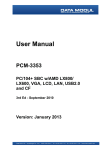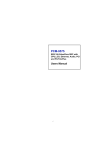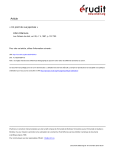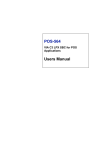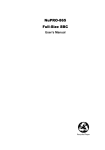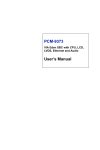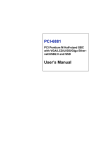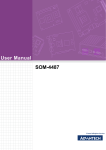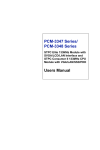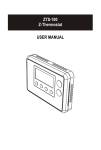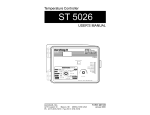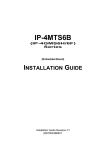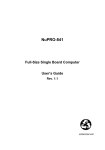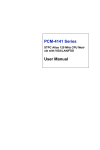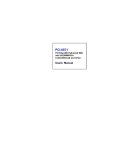Download POS-761 Manual_ed1.book
Transcript
POS-761F
Socket 370 SBC for POS, Kiosks
and Gaming applications
User’s Manual
Copyright
This document is copyrighted, © 2003. All rights are reserved. The original manufacturer reserves the right to make improvements to the products
described in this manual at any time without notice.
No part of this manual may be reproduced, copied, translated or transmitted in any form or by any means without the prior written permission of
the original manufacturer. Information provided in this manual is
intended to be accurate and reliable. However, the original manufacturer
assumes no responsibility for its use, nor for any infringements upon the
rights of third parties that may result from such use.
Acknowledgements
Award is a trademark of Award Software International, Inc.
VIA is a trademark of VIA Technologies, Inc.
IBM, PC/AT, PS/2 and VGA are trademarks of International Business
Machines Corporation.
Intel and Pentium are trademarks of Intel Corporation.
Microsoft Windows® is a registered trademark of Microsoft Corp.
RTL is a trademark of Realtek Semi-Conductor Co., Ltd.
ESS is a trademark of ESS Technology, Inc.
UMC is a trademark of United Microelectronics Corporation.
SMI is a trademark of Silicon Motion, Inc.
Creative is a trademark of Creative Technology LTD.
All other product names or trademarks are properties of their respective
owners.
For more information on this and other Advantech products, please visit
our websites at:
http://www.advantech.com
http://www.advantech.com/ppc
For technical support and service, please visit our support website at:
http://support.advantech.com
This manual is for the PPC-123.
Part No. 2007076110
1st Edition, Feb. 2003
POS-761F User’s Manual
ii
FCC Class B
This equipment has been tested and found to comply with the limits for a
Class B digital device, pursuant to Part 15 of the FCC Rules. These limits
are designed to provide reasonable protection against harmful interference when the equipment is operated in a residential environment. This
equipment generates, uses and can radiate radio frequency energy. If not
installed and used in accordance with this user's manual, it may cause
harmful interference to radio communications. Note that even when this
equipment is installed and used in accordance with this user's manual,
there is still no guarantee that interference will not occur. If this equipment is believed to be causing harmful interference to radio or television
reception, this can be determined by turning the equipment on and off. If
interference is occurring, the user is encouraged to try to correct the interference by one or more of the following measures:
• Reorient or relocate the receiving antenna
• Increase the separation between the equipment and the receiver
• Connect the equipment to a power outlet on a circuit different from that
to which the receiver is connected
• Consult the dealer or an experienced radio/TV technician for help
Warning!
Any changes or modifications made to the
equipment which are not expressly approved by
the relevant standards authority could void your
authority to operate the equipment.
iii
Packing List
Before you begin installing your card, please make sure that the following
materials have been shipped:
• 1 POS-761F all-in one single board computer
• 1 CD-ROM or disks for utility, drivers, and manual (in PDF format)
• 1 warranty certificate
• 1 UDMA 66 40-pin flat cable
• 1 startup manual
• 2 serial port cables
• 1 audio cable (optional)
If any of these items are missing or damaged, contact your distributor or
sales representative immediately.
POS-761F User’s Manual
iv
Additional Information and Assistance
Step 1. Visit the Advantech web site at www.advantech.com where you
can find the latest information about the product.
Step 2. Contact your distributor, sales representative, or Advantech's
customer service center for technical support if you need additional assistance. Please have the following information ready
before you call:
• Product name and serial number
• Description of your peripheral attachments
• Description of your software (operating system, version, application
software, etc.)
• A complete description of the problem
• The exact wording of any error messages
v
Safety Instructions
1. Read these safety instructions carefully.
2. Keep this User's Manual for later reference.
3. Disconnect this equipment from any AC outlet before cleaning. Use a damp
cloth. Do not use liquid or spray detergents for cleaning.
4. For plug-in equipment, the power outlet socket must be located near the
equipment and must be easily accessible.
5. Keep this equipment away from humidity.
6. Put this equipment on a reliable surface during installation. Dropping it or letting it fall may cause damage.
7. The openings on the enclosure are for air convection. Protect the equipment
from overheating. DO NOT COVER THE OPENINGS.
8. Make sure the voltage of the power source is correct before connecting the
equipment to the power outlet.
9. Position the power cord so that people cannot step on it. Do not place anything
over the power cord.
10. All cautions and warnings on the equipment should be noted.
11. If the equipment is not used for a long time, disconnect it from the power
source to avoid damage by transient overvoltage.
12. Never pour any liquid into an opening. This may cause fire or electrical shock.
13. Never open the equipment. For safety reasons, the equipment should be
opened only by qualified service personnel.
14. If one of the following situations arises, get the equipment checked by service
personnel:
a. The power cord or plug is damaged.
b. Liquid has penetrated into the equipment.
c. The equipment has been exposed to moisture.
d. The equipment does not work well, or you cannot get it to work according
to the user's manual.
e. The equipment has been dropped and damaged.
f. The equipment has obvious signs of breakage.
15. DO NOT LEAVE THIS EQUIPMENT IN AN ENVIRONMENT WHERE
THE STORAGE TEMPERATURE MAY GO BELOW -20° C (-4° F) OR
ABOVE 60° C (140° F). THIS COULD DAMAGE THE EQUIPMENT. THE
EQUIPMENT SHOULD BE IN A CONTROLLED ENVIRONMENT.
16. CAUTION: DANGER OF EXPLOSION IF BATTERY IS INCORRECTLY
REPLACED.REPLACE ONLY WITH THE SAME OR EQUIVALENT
TYPE RECOMMENDED BY THE MANUFACTURER, DISCARD USED
BATTERIES ACCORDING TO THE MANUFACTURER'S INSTRUCTIONS.
The sound pressure level at the operator's position according to IEC 704-1:1982 is
no more than 70 dB (A).
DISCLAIMER: This set of instructions is given according to IEC 704-1. Advantech disclaims all responsibility for the accuracy of any statements contained
herein.
POS-761F User’s Manual
vi
Wichtige Sicherheishinweise
1. Bitte lesen sie Sich diese Hinweise sorgfältig durch.
2. Heben Sie diese Anleitung für den späteren Gebrauch auf.
3. Vor jedem Reinigen ist das Gerät vom Stromnetz zu trennen. Verwenden Sie
Keine Flüssig-oder Aerosolreiniger. Am besten dient ein angefeuchtetes Tuch
zur Reinigung.
4. Die NetzanschluBsteckdose soll nahe dem Gerät angebracht und leicht
zugänglich sein.
5. Das Gerät ist vor Feuchtigkeit zu schützen.
6. Bei der Aufstellung des Gerätes ist auf sicheren Stand zu achten. Ein Kippen
oder Fallen könnte Verletzungen hervorrufen.
7. Die Belüftungsöffnungen dienen zur Luftzirkulation die das Gerät vor überhitzung schützt. Sorgen Sie dafür, daB diese Öffnungen nicht abgedeckt werden.
8. Beachten Sie beim. AnschluB an das Stromnetz die AnschluBwerte.
9. Verlegen Sie die NetzanschluBleitung so, daB niemand darüber fallen kann.
Es sollte auch nichts auf der Leitung abgestellt werden.
10. Alle Hinweise und Warnungen die sich am Geräten befinden sind zu
beachten.
11. Wird das Gerät über einen längeren Zeitraum nicht benutzt, sollten Sie es vom
Stromnetz trennen. Somit wird im Falle einer Überspannung eine Beschädigung vermieden.
12. Durch die Lüftungsöffnungen dürfen niemals Gegenstände oder Flüssigkeiten
in das Gerät gelangen. Dies könnte einen Brand bzw. elektrischen Schlag auslösen.
13. Öffnen Sie niemals das Gerät. Das Gerät darf aus Gründen der elektrischen
Sicherheit nur von authorisiertem Servicepersonal geöffnet werden.
14. Wenn folgende Situationen auftreten ist das Gerät vom Stromnetz zu trennen
und von einer qualifizierten Servicestelle zu überprüfen:
a - Netzkabel oder Netzstecker sind beschädigt.
b - Flüssigkeit ist in das Gerät eingedrungen.
c - Das Gerät war Feuchtigkeit ausgesetzt.
d - Wenn das Gerät nicht der Bedienungsanleitung entsprechend funktioniert
oder Sie mit Hilfe dieser Anleitung keine Verbesserung erzielen.
e - Das Gerät ist gefallen und/oder das Gehäuse ist beschädigt.
f - Wenn das Gerät deutliche Anzeichen eines Defektes aufweist.
15. VOSICHT: Explisionsgefahr bei unsachgemaben Austausch der Batterie.Ersatz nur durch densellben order einem vom Hersteller empfohlenemahnlichen Typ. Entsorgung gebrauchter Batterien navh Angaben des
Herstellers.
Der arbeitsplatzbezogene Schalldruckpegel nach DIN 45 635 Teil 1000
beträgt 70dB(A) oder weiger.
DISCLAIMER: This set of instructions is given according to IEC704-1.
Advantech disclaims all responsibility for the accuracy of any statements
contained herein.
vii
Caution!
Danger of explosion if battery is incorrectly
replaced. Replace only with the same or equivalent type recommended by the manufacturer.
Dispose of used batteries according to the manufacturer’s instructions.
POS-761F User’s Manual
viii
Contents
Chapter
1 General Information ........................................2
1.1
1.2
1.3
1.4
Introduction ....................................................................... 2
Features ............................................................................. 3
Specifications .................................................................... 4
Board Dimensions ............................................................. 6
Figure 1.1:Board Dimensions (Component Side)........... 6
Figure 1.2:Board Dimensions (Solder Side)................... 7
Chapter
2 Installation ......................................................10
2.1
Jumpers............................................................................ 10
2.2
2.3
Connectors....................................................................... 10
Locating jumpers and connectors.................................... 13
2.4
Setting Jumpers ............................................................... 14
2.5
CPU installation and upgrading ...................................... 15
Table 2.1:Jumpers......................................................... 10
Figure 2.1:Locating Jumpers ........................................ 13
Figure 2.2:Locating Connectors (Component Side) ..... 14
2.5.1
2.5.2
2.6
Installing a CPU in the ZIF socket................................ 16
CMOS clear (J4) ........................................................... 17
Table 2.3:CMOS clear (J4)........................................... 17
DRAM installation .......................................................... 17
2.6.1
DIMM DRAM (DIMM 1 and DIMM 2) ...................... 17
2.7
Primary (3.5") IDE connector (CN12) ............................ 17
2.8
2.9
Secondary (2.5") IDE connector (CN10) ........................ 18
FDD connector (CN13)................................................... 18
2.7.1
2.9.1
Connecting the hard drive............................................. 18
Connecting the floppy drive ......................................... 19
2.10
2.11
2.12
LPT1 (primary parallel port) connectors . (CN28/CN29)19
LPT2 (secondary parallel port) connector (CN30) ......... 19
Keyboard/mouse connectors (CN4, CN6) ...................... 20
2.13
Power connectors (CN5, CN7, CN1,CN19) ................... 20
Table 2.4:Keyboard/mouse select (J1).......................... 20
2.13.1 Main power connector (CN5) ....................................... 20
2.13.2 ATX power input connector (CN7) .............................. 20
2.13.3 Fan power supply connector (CN1,CN19) ................... 20
2.14
Audio interfaces (CN2, CN3).......................................... 20
2.14.1 Audio connector (CN3) ................................................ 21
2.14.2 CD audio-in connector (CN2)....................................... 21
2.15
Serial (COM1- 4)(CN20/21,CN14/16,CN25,CN22) ...... 21
2.15.1 Primary(COM1:CN20/CN21,COM2:CN14/CN16) ..... 21
2.15.2 Secondary(COM3: CN25, COM4: CN22) ................... 21
ix
2.16
COM2 RS-232/422/485 (J10, J11 and J12) .................... 22
2.17
COM1- 4 RI pin +5/+12V (J15,J16,J14,J17) .................. 22
Table 2.5:COM2 RS-232/422/485 (J10, J11 & J12) .... 22
Table 2.6:COM1, COM2 RI/power select (J15)........... 22
Table 2.7:COM1, COM2 RI/power select (J16)........... 22
Table 2.8:COM3, COM4 R1/power select (J17).......... 22
2.18
VGA interface connections ............................................. 23
2.18.1 CRT display connector (CN36 and CN37)................... 23
2.18.2 Flat panel display connector (CN31) ............................ 23
Table 2.9:COM3, COM4 R1/power select (J14).......... 23
2.18.3 LCD power setting (J20)............................................... 24
Table 2.10:LCD power (J20) ........................................ 24
2.19
Ethernet configuration..................................................... 24
2.19.1 RJ-45 connector (CN11)............................................... 24
2.19.2 Network boot ................................................................ 24
2.20
Watchdog timer configuration ........................................ 25
2.20.1 Watchdog timer action (J13)......................................... 25
Table 2.11:Watchdog Function J13 .............................. 25
2.21
2.22
USB connector (CN26,CN27)......................................... 25
DOC® 2000 address select (J44) .................................... 26
2.23
2.24
Mouse and IRQ12 function select (J1)............................ 27
Digital I/O (J7: 4 Outputs, 4 Inputs) ............................... 27
Table 2.12:DOC® 2000 address select (J44) ............... 26
2.24.1 Digital output programming ......................................... 28
Table 2.14:Digital output programming ....................... 28
2.24.2 Digital output solenoid wiring examples ...................... 28
Figure 2.3:POS-761F digital output solenoid wiring.... 29
Chapter
3 Software Configuration .................................32
3.1
3.2
Introduction ..................................................................... 32
VGA display firmware configuration ............................. 32
3.3
Connections for four standard LCDs .............................. 34
3.4
Ethernet software configuration ...................................... 38
Figure 3.1:VGA setup screen........................................ 33
Table 3.1:Sharp LM64183P LCD (CN35) ................... 34
Chapter
4 Award BIOS Setup.........................................40
4.1
System test and initialization........................................... 40
4.1.1
4.2
System configuration verification................................. 40
Award BIOS setup .......................................................... 41
4.2.1
4.2.2
4.2.3
POS-761F User’s Manual
Entering setup ............................................................... 41
Figure 4.1:Setup Program Initial Screen....................... 41
Standard CMOS setup .................................................. 41
Figure 4.2:CMOS Setup Screen.................................... 42
BIOS features setup ...................................................... 43
x
Figure 4.3:BIOS Features Setup Screen ....................... 43
Chipset features setup ................................................... 44
Figure 4.4:ChipsetFeatures Setup Screen ..................... 44
4.2.5 Power management setup ............................................. 45
Figure 4.5:Power Management Setup Screen............... 45
4.2.6 PnP/PCI configuration setup......................................... 46
Figure 4.6:PCI configuration setup screen ................... 46
4.2.7 Integrated peripherals ................................................... 47
Figure 4.7:Integrated peripherals setup screen ............. 47
4.2.8 Load Optimized Defaults BIOS.................................... 48
Figure 4.8:Load Optimized Default BIOS screen ........ 48
4.2.9 Set Password ................................................................. 48
4.2.10 Save & exit setup ......................................................... 49
Figure 4.9:Save and Exit Setup Screen......................... 49
4.2.11 Quit without saving....................................................... 50
Figure 4.10:Quit Setup Screen...................................... 50
4.2.4
Chapter
5 AGP 2X Setup.................................................52
5.1
Introduction ..................................................................... 52
5.1.1
5.1.2
5.1.3
5.1.4
5.2
Installation of the SVGA Driver ..................................... 54
5.2.1
5.2.2
5.2.3
5.2.4
5.2.5
5.3
Chapter
Installation for Windows 95 ......................................... 54
Installation for Windows 98/Me ................................... 58
Installation for Windows NT ........................................ 63
Installation for Windows 2000 ..................................... 68
Installation for Windows XP ........................................ 73
Further Information ......................................................... 79
6 Audio Setup.....................................................82
6.1
6.2
Introduction ..................................................................... 82
DOS utilities.................................................................... 82
6.2.1
6.2.2
6.3
VIA Sound Blaster Pro compatible set up program ..... 82
VIA Sound Blaster Installation..................................... 82
Driver installation............................................................ 83
6.3.1
Chapter
Chipset .......................................................................... 52
Display memory............................................................ 52
Display types................................................................. 52
Dual/Simultaneous Display .......................................... 53
Figure 5.1:Selecting Display Settings........................... 53
Before you begin........................................................... 83
7 PCI Bus Ethernet Interface.........................100
7.1
7.2
Introduction ................................................................... 100
Installation of Ethernet Driver....................................... 100
7.2.1
7.2.2
7.2.3
Installation for MS-DOS and Windows 3.1................ 100
Installation for Windows 95 ....................................... 101
Installation for Windows 2000 ................................... 103
xi
7.2.4
7.3
Installation for Windows NT ...................................... 109
Further information ....................................................... 111
Appendix A Programming the Watchdog Timer ...........114
A.1
Programming the watchdog timer ................................. 114
Appendix B POS-761 Jumper Settings............................118
B.1
B.2
B.3
B.4
B.5
B.6
B.7
B.8
B.9
B.10
B.11
B.12
B.13
B.14
B.15
B.16
B.17
B.18
B.19
B.20
B.21
B.22
B.23
B.24
B.25
B.26
B.27
B.28
B.29
B.30
B.31
B.32
B.33
B.34
B.35
B.36
CN1 System FAN connector......................................... 120
CN2 CD IN connector................................................... 120
CN3 Audio connector.................................................... 120
CN4 First 6 Pins Mini DIM for KB .............................. 120
CN6 Int. KB/MOUSE connect...................................... 120
CN8 Second LAN connect............................................ 121
CN9 Second 6 Pins Mini DIM for Mouse..................... 121
CN10 Secondary IDE.................................................... 121
CN11 First LAN connect .............................................. 122
CN12 Primary IDE........................................................ 122
CN14 COM2 connect.................................................... 122
CN15 USB1.0 1 & 2 connect ........................................ 123
CN16 COM2 D-TYPE 9 Pins connect.......................... 123
CN17 USB1.0 3 & 4 connect ........................................ 123
CN19 CPU FAN............................................................ 123
CN20 COM1 D-TYPE 9 Pins connect.......................... 123
CN21 COM1 connect.................................................... 124
CN22 COM4 connect.................................................... 124
CN24 LVDS connect .................................................... 124
CN25 COM3 connect.................................................... 125
CN26 USB2.0 1 & 2 connect ........................................ 125
CN27 USB2.0 3 & 4 connect ........................................ 125
CN28 LPT1 D-TYPE 25 Pins connect.......................... 125
CN29 LPT1 connect...................................................... 126
CN30 LPT2 connect...................................................... 126
CN31 For LCD 36 Bits connect.................................... 126
CN32 LCD Brightness controller connect .................... 127
CN33 LCD Contrast controller connect........................ 127
CN34 Backlight connect ............................................... 127
CN35 For LCD 18 Bits connect.................................... 127
CN36 VGA D-TYPE 15 Pins connect .......................... 128
CN37 VGA connect ...................................................... 128
CN38 I2C Bus ............................................................... 128
CN39 Compact Flash(Secondary IDE Master)............. 129
J1 Mouse and IRQ12 function select ............................ 129
J2 Setting CN9 DATSEL and CLKSEL function......... 129
POS-761F User’s Manual
xii
B.37
B.38
B.39
B.40
B.41
B.42
B.43
B.44
B.45
B.46
B.47
B.48
B.49
B.50
B.51
B.52
B.53
B.54
J4 Clear CMOS ............................................................. 130
J5 DOC2K address select.............................................. 130
DIO address select......................................................... 130
J6 Front pane ................................................................. 130
J7 DIO connect.............................................................. 130
J8 CF card power........................................................... 131
J9 SIR connect............................................................... 131
J10,J11,J12 COM2 RS232/422/485 function................ 132
J13 Setting WatchDog trigger event ............................. 132
J14 COM3 and COM4 power select ............................. 132
J15 COM1 and COM2 pin 9 function select................. 132
J16 COM1 and COM2 power select ............................. 132
J17 COM3 and COM4 pin 9 function select................. 132
J18 FIR connect............................................................. 133
J19 Setting Enable backlight signal level...................... 133
J20 Setting LCD Power................................................. 133
BT1 BATTERY SOCKET............................................ 133
DOC2000 socket ........................................................... 134
Appendix C DOC® 2000 Installation Guide ...................138
C.1
DiskOnChip®2000 Quick Installation Guide ............... 138
C.1.1
C.1.2
DiskOnChip® 2000 installation instructions.............. 138
Additional information and assistance........................ 139
xiii
POS-761F User’s Manual
xiv
CHAPTER
1
General Information
This chapter gives background information on the POS-761F.
Sections include:
• Sections include:
• Introduction
• Features
• Specifications
• Board layout and dimensions
Chapter 1 General Information
1.1 Introduction
The POS-761F utilizes an LPX form factor (Socket 370) design that supports Celeron processors and Pentium III processors up to 1.26 GHz
Tualatin code CPU at 133 MHz FSB bus. This effective LPX Socket 370
solution gives end users the choice of good, economical performance
with the Celeronô series processors, or the impressive performance of the
Pentium III series. Also, compared to Slot 1 solutions, the Socket 370's
lower profile allows for a lower board height, critical to embedded systems applications. This processor flexibility combined with all the other
on-board features, explains why the POS-761F is the new top-of-the-line
POS solution at Advantech.
The POS-761F is loaded with special on-board features that rival full-size
systems. It has standard 10/100Base-T PCI Ethernet, 36-bit DSTN/TFT
LCD panel support as well as SSD support for DOCÆ 2000 and CompactFlashô. There is a Mini PCI socket for optional international version
modem, plus optional support for AC97 3D stereo surround sound with
speaker-out, CD-input, line-in, line-out and microphone. The POS-761F
also includes two 168-pin DIMM sockets for up to 1 GB total on-board
memory.
The POS-761F was designed using feedback and knowledge gained from
our customers. It has more of the features our customers have requested.
It is 100% PC compatible and is ready to handle the most challenging
POS environments. Besides the great onboard memory flexibility and
capacity, the POS-761F has four on-board serial ports, each with +5/+12
V power, two USB connectors, watchdog timer and tough industrial
grade construction. The Award 256 KB Flash BIOS supports Plug &
Play, Boot from Ethernet, Boot from CD-ROM, Boot from Zip drive,
Wake-on-Lan, Modem and LCD backlight turnoff. All these features
make the POS-761F a very "system integrator friendly" solution, perfect
for handling POS applications in the harshest unmanned environments.
POS-761F User’s Manual
2
1.2 Features
• All-in-one design simplifies system integration and increases system
stability
• Socket 370 supports Celeron and Pentium® III processors, up to 1.26
GHz (Tualatin Code) oandabove.
• On-board POS features such as 4 x RS-232 with power and 4 x USB
interfaces for external peripherals.
• 100/10Base-T with RJ-45 connection for the most demanding networking environment
• Supports Mini PCI interface for optional modem
• Supports wake-on LAN, modem
• 16-bit full-duplex 3D audio optional for quality multimedia sound
applications
• Special industrial features not found on conventional motherboards
include watchdog timer, SSD and High Drive digital I/O for driving
cash drawer
• Standardized layout conforms to Western Digital LPM/LPX format for
easy installation within standard sized chassis
• Supports up to 36-bit DSTN/TFT high resolution LCDs
• Advanced CPU switching power technology for stable and low heat
CPU voltage power conversion
• Supports DiskOnChipÆ Flash modules and CompactFlash™ card
3
Chapter 1
1.3 Specifications
Standard SBC functions
• CPU: Socket 370 for Intel® Celeron™/Pentium III Tualatin code processor
• BIOS: Award 256 KB Flash memory
• Chipset: VIA 8606/TwisterT, VT82C686B
• System memory: Two DIMM sockets accept 32 MB ~ 1 GB SDRAM
• Enhanced IDE interface: Supports up to four EIDE devices. BIOS
auto-detect, PIO Mode 3 or Mode 4, UDMA/33 transfer, UDMA/66
transfer
• FDD interface: Supports up to two FDDs
• Serial ports: Four serial RS-232 ports, COM1, 3, 4: RS-232, COM2:
RS-232/422/485
• Parallel port: Two parallel ports, supports SPP/EPP/ECP mode
• Infrared port: Shared with COM2. Transfer rates up to 4 Mbps
• Keyboard/mouse connector: Supports standard PC/AT keyboard and
a PS/2 mouse
• Power management: Supports power saving modes including Normal/
Standby/Suspend modes. APM 1.1 compliant
• Watchdog timer: 62 level timer intervals
• USB: Four universal serial bus ports (USB2.0)
Solid state disk
• Supports one 50-pin socket for CompactFlash™ card and one 32-pin
socket for a DiskOnChip®
VGA/LCD interface
• Chipset: VIA VT8606/TwisterT, optimized Shared Memory Architecture, support 8/16/32 MB frame buffer using system memory.
• Interface: 4X AGP interface
• Display mode: Flat panel displays up to 600 x 480 @ 18 bpp 800 x 600
@ 18 bpp, 1024 x 768 @ 18 bpp, CRT monitors up to 800 x 600 @ 24
bpp, 1024 x 768 @ 16 bpp, 1280 x 1024@16 bpp
Ethernet interface
• Chipset: Reatlek RTL8139C, Intel 82551, Intel 82551ER
POS-761F User’s Manual
4
• Ethernet interface: PCI 10/100 Mbps Ethernet. IEEE 802.3 U protocol compatible
• Connection: On-board RJ-45 connector
• I/O address switchless setting
• Built-in boot ROM
Audio function (optional)
• Chipset: VIA 82C686B
• Audio controller: AC97 version 2.0 compliant interface
• Audio interface: Microphone in, line in, CD audio in, line out, speaker
L and Speaker R
Mechanical and environmental
• Max. power requirements:+5 V ± 5% @ 26 A, +12 V ± 5% @ 1.4 A
• Operating temperature: 0 ~ 60° C (32 ~ 140° F)
• Dimensions (L x W): 220 x 235 mm (8.7" x 9.25")
• Weight: 0.5 kg (1.1 lb)
5
Chapter 1
1.4 Board Dimensions
Figure 1.1: Board Dimensions (Component Side)
POS-761F User’s Manual
6
K
Figure 1.2: Board Dimensions (Solder Side)
7
Chapter 1
POS-761F User’s Manual
8
CHAPTER
2
Installation
This chapter explains how to set up the
POS-761F hardware, including instructions on setting jumpers and connecting
peripherals, switches and indicators. Be
sure to read all the safety precautions
before you begin the installation procedure.
Chapter 2 Installation
2.1 Jumpers
The POS-761F has a number of jumpers that allow you to configure your
system to suit your application. The table below lists the function of each
of the board's jumpers
Table 2.1: Jumpers
J1
Mouse and IRQ12 function select
J2
Setting CN9 DATSEL and CLKSEL function
J4
Clear CMOS
J5
DOC2K and DIO address select
J6
Front pane
J7
DIO connect
J8
CF card power
J9
SIR connect
J10,J11,J12
J13
Setting WatchDog trigger event
J14
COM3 and COM4 power select
J15
COM1 and COM2 pin 9 function select
J16
COM1 and COM2 power select
J17
COM3 and COM4 pin 9 function select
J18
FIR connect
J19
Setting Enable backlight signal level
J20
Setting LCD Power
2.2 Connectors
On-board connectors link the POS-761F to external devices such as hard
disk drives, a keyboard, or floppy drives. The tables below lists the function of each of the board's connectors
POS-761F User’s Manual
10
.
Table 2.2: Connectors
1.
CN1
System fan connect
2.
CN2
CD IN connect
3.
CN3
Audio connect
4.
CN4
First 6 Pins Mini DIM for KB
5.
CN5
AT Power connect
6.
CN6
Int. KB/MOUSE connect
7.
CN7
ATX Power connect
8.
CN8
Second LAN connect
9.
CN9
Second 6 Pins Mini DIM for Mouse
10.
CN10
Secondary IDE
11.
CN11
First LAN connect
12.
CN12
Primary IDE
13.
CN13
FDD connect
14.
CN14
COM2 connect
15.
CN15
16.
CN16
COM2 D-TYPE 9 Pins connect
17.
CN17
USB1.0 3 & 4 connect
18.
CN18
PISA Slot
19.
CN19
CPU FAN
20.
CN20
COM1 D-TYPE 9 Pins connect
21.
CN21
COM1 connect
22.
CN22
COM4 connect
23.
CN24
LVDS connect
24.
CN25
COM3 connect
25.
CN26
USB2.0 1 & 2 connect
26.
CN27
USB2.0 3 & 4 connect
27.
CN28
LPT1 D-TYPE 25 Pins connect
28.
CN29
LPT1 connect
29.
CN30
LPT2 connect
30.
CN31
For LCD 36 Bits connect
11
Chapter 2
Table 2.2: Connectors
31.
CN32
LCD Brightness controller connect
32.
CN33
LCD Contrast controller connect
33.
CN34
Backlight connect
34.
CN35
For LCD 18 Bits connect
35.
CN36
VGA D-TYPE 15 Pins connect
36.
CN37
VGA connect
37.
CN38
I2C Bus
38.
CN39
Compact Flash(Secondary IDE Master)
39.
J1
Mouse and IRQ12 function select
40.
J2
Setting CN9 DATSEL and CLKSEL function
41.
J4
Clear CMOS
42.
J5
DOC2K and DIO address select
43.
J6
Front pane
44.
J7
DIO connect
45.
J8
CF card power
46.
J9
SIR connect
47.
J10,J11,J
12
Setting COM2 RS232/RS422/RS485 function
48.
J13
Setting WatchDog trigger event
49.
J14
COM3 and COM4 power select
50.
J15
COM1 and COM2 pin 9 function select
51.
J16
COM1 and COM2 power select
52.
J17
COM3 and COM4 pin 9 function select
53.
J18
FIR connect
54.
J19
Setting Enable backlight signal level
55.
J20
Setting LCD Power
56.
BT1
BATTERY SOCKET
57.
DIMM1
SDRAM Socket
58.
DIMM2
SDRAM Socket
59.
U2
DOC2000 socket
60.
U26
Socket 370 for PIII CPU
POS-761F User’s Manual
12
2.3 Locating jumpers and connectors
Figure 2.1: Locating Jumpers
13
Chapter 2
Figure 2.2: Locating Connectors (Component Side)
2.4 Setting Jumpers
You configure your board to match the needs of your application by setting jumpers. A jumper is the simplest kind of electric switch. It consists
of two metal pins and a small metal clip (often protected by a plastic
cover) that slides over the pins to connect them. To ìcloseî a jumper you
connect the pins with the clip. To ìopenî a jumper you remove the clip.
Sometimes a jumper will have three pins, labeled 1, 2, and 3. In this case
you would connect either pins 1 and 2 or 2 and 3.
POS-761F User’s Manual
14
open
closed
closed 2-3
The jumper settings are schematically depicted in this manual as follows:
open
closed
closed 2-3
A pair of needle-nose pliers may be helpful when working with jumpers.
If you have any doubts about the best hardware configuration for your
application, contact your local distributor or sales representative before
you make any changes.
Generally, you simply need a standard cable to make most connections.
2.5 CPU installation and upgrading
You can upgrade to a higher power PentiumÆ processor at any time.
Simply remove the old CPU, install the new one, and the BIOS will auto
detect the new CPU type and speed.
15
Chapter 2
Warning!
Always disconnect the power cord from your
chassis when you are working on it. Do not make
connections while the power is on as sensitive
electronic components can be damaged by the
sudden rush of power. Only experienced electronics personnel should open the PC chassis
Caution!
Always ground yourself to remove any static
charge before touching the PC board. Modern
electronic devices are very sensitive to static
electric charges. Use a grounding wrist strap at
all times. Place all electronic components on a
static-dissipative surface or in a static-shielded
bag when they are not in the chassis.
2.5.1 Installing a CPU in the ZIF socket
POS-761F provides a Zero Insertion Force (ZIF) socket for easy CPU
installation.
1.
Make sure the ZIF socket lever is in the upright position. To raise
the lever, pull it out to the side a little and raise it as far as it will go.
2.
Place the CPU in the empty socket. Follow the instructions that
came with the CPU. If you have no instructions, do the following:
Carefully align the CPU so it is parallel to the socket and the notch
on the corner of the CPU corresponds with the notch on the inside
of the socket. Gently slide the CPU in. It should insert easily. If it
does not, pull the lever up a little more.
3.
Press the lever down. The plate will slide forward. You will feel
some resistance as the pressure starts to secure the CPU in the
socket. This is normal and will not damage the CPU.
When the CPU is installed, the lever should snap into place at the side of
the socket.
Note:
To remove a CPU, pull the lever out to the side a
little and raise it
POS-761F User’s Manual
16
2.5.2 CMOS clear (J4)
Warning!
To avoid damaging the computer, always turn off
the power supply before setting “Clear CMOS.”
Set the jumper back to “3V Battery On” before
turning on the power supply.
Table 2.3: CMOS clear (J4)
*3.0 V battery on
Clear CMOS
J4
* default setting
2.6 DRAM installation
There are two on-board 168-pin DIMM sockets.
2.6.1 DIMM DRAM (DIMM 1 and DIMM 2)
You can install one DiMM (up to 512 MB) or two 168-pin DIMM (up to
1 GB DRAM) in the DIMM sockets.
Caution!
When installing DIMM, make sure the module is
oriented properly. Do not use excess force during installation.
2.7 Primary (3.5") IDE connector (CN12)
The 40-pin IDE connector supports up to two 40-pin IDE interface
devices, including CD-ROM drives, tape-backup drives, HDDs, etc.
When connecting, make sure pin 1 of the connector is matched with pin
of the device's connector.
17
Chapter 2
The built-in Enhanced IDE (Integrated Device Electronics) controller
supports up to two IDE devices, including CD-ROM drives, tape backup
drives, a large hard disk drive and other IDE devices. It also supports
faster data transfer rates and allows IDE hard disk drives with capacities
in excess of 528 MB.
2.7.1 Connecting the hard drive
Connecting drives is done in a daisy-chain fashion. Wire number 1 on the
cable is red or blue, while the other wires are gray.
Unlike floppy drives, IDE hard drives can connect to either end of the
cable. If you install two drives, you will need to set one as the master and
one as the slave by using jumpers on the drives. If you install just one
drive, set it as the master.
2.8 Secondary (2.5") IDE connector (CN10)
The on-board 44-pin mini-pitched IDE interface is used to let user support either a 2.5" HDD.
Follow the same connection arrangement as the 3.5" HDD if you want to
connect to a 2.5" IDE device. Read the BIOS setup section for more
information regarding system settings.
Note:
You cannot use a DMA-66 HDD, due to the
cableís limitation.
2.9 FDD connector (CN13)
You can attach up to two floppy disks to the POS-761F's on-board controller. You can use any combination of 5º" (360 KB and 1.2 MB) and/or
3¾" (720 KB, 1.44 MB, and 2.88 MB) drives.
A 34-pin daisy-chain drive connector cable is required for a dual-drive
system. On one end of the cable is a 34-pin flat-cable connector. On the
other end are two sets of floppy disk drive connectors. Each set consists
of a 34-pin flat-cable connector (usually used for 3¾" drives) and a
printed-circuit board connector (usually used for 5º" drives).
POS-761F User’s Manual
18
2.9.1 Connecting the floppy drive
1.
Plug the 34-pin flat-cable connector into CN13. Make sure that the
red wire corresponds to pin one on the connector.
2.
Attach the appropriate connector on the other end of the cable to
the floppy drive(s). You can use only one connector in the set. The
set on the end (after the twist in the cable) connects to the A: drive.
The set in the middle connects to the B: drive.
3.
If you are connecting a 5º" floppy drive, line up the slot in the
printed circuit board with the blocked-off part of the cable connector. If you are connecting a 3¾" floppy drive, you may have trouble
determining which pin is pin number one. Look for a number
printed on the circuit board indicating pin number one. Also, the
connector on the floppy drive connector may have a slot. When the
slot is up, pin number one should be on the right. Check the documentation that came with the drive for more information. The B:
drive can be attached to the connectors in the middle of the cable as
described above.
2.10 LPT1 (primary parallel port) connectors (CN28/
CN29)
The primary parallel printer port is located at the rear edge of the board,
and has a DB-25 connector. This printer port is typically used to connect
a printer via an adapter cable. LPT1's IRQ setting is defined as IRQ7.
You can select Normal/EPP/ECP for LPT1, and enable/disable it in BIOS
(see Chapter 4). There is another internal parallel port connector, CN29,
also available.
2.11 LPT2 (secondary parallel port) connector (CN30)
The secondary parallel port is located next to and on the inner side of the
primary parallel port. This secondary port has a 26-pin box header.
LPT2ís IRQ setting is defined as IRQ9. You can select Printer/EPP/ECP/
SPP for LPT2, and enable/disable it in BIOS (see Chapter 4).
19
Chapter 2
2.12 Keyboard/mouse connectors (CN4, CN6)
The POS-761F is uniquely designed to allow 3 ways for keyboard and
mouse input. Please note that only one keyboard and one mouse can be
connected at one time.
• External mini-DIN PS/2 keyboard/mouse jack (CN4)
• Internal 6-pin KB/Mouse connector (CN6)
• External mini-DIN PS/2 mouse/keyboard jack (CN4) selected by J1
Table 2.4: Keyboard/mouse select (J1)
Closed pins
Result
1-3, 2-4
Keyboard and mouse
3-5, 4-6
Mouse only*
2.13 Power connectors (CN5, CN7, CN1,CN19)
2.13.1 Main power connector (CN5)
The power connection is a 12-pin connector (PS/2 or AT power standard)
requiring ±5 V and ±12 V power. Always keep the ground wires (black
color) toward the middle when connecting the power wire from the power
supply.
2.13.2 ATX power input connector (CN7)
The power connection is a 20-pin connector requiring ±5 V and ±12 V
and 5VSB single.
2.13.3 Fan power supply connector (CN1,CN19)
There are two FAN connector provided, CN1 is system FAN, CN19 is
optional CPU cooling fan.Only present when +5 V and +12 V power is
supplied to the board.
2.14 Audio interfaces (CN2, CN3)
The POS-761FA is equipped with a high quality audio interface, which
provides 16-bit CD-quality recording and playback as well as OPL3 compatible FM music. It is supported by all major operating systems and is
100% Sound Blaster Pro compatible.
POS-761F User’s Manual
20
2.14.1 Audio connector (CN3)
The POS-761FA provides all major audio signals on a 16-pin flat-cable
connector, CN3. These audio signals include Microphone in (mono), Line
in (stereo), Line out (stereo), and Speaker out (stereo). You will need an
adapter cable if you use traditional telephone jack connectors for these
audio signals.
2.14.2 CD audio-in connector (CN2)
All CD-ROM drives can provide analog audio signal output when used as
a music CD player. The CN2 on POS-761FA is a connector to input CD
audio signal into the audio controller. The audio cable of your CD-ROM
drive will be used to connect to CN2.
2.15 Serial (COM1- 4)(CN20/21,CN14/16,CN25,CN22)
The POS-761F has a total of four on-board RS-232 serial ports, COM1-4.
They are differentiated by COM1 and COM2 (RS-232/422/485) as primary serial ports and COM3 and COM4 as secondary ports. All four
serial ports have +5 V and +12 V power capabilities on both pin #1 and
pin #9, depending on the jumper setting. Pin assignments for both internal
and external COM ports can be found in the appendix.
2.15.1 Primary(COM1:CN20/CN21,COM2:CN14/CN16)
Each primary serial port has two connections, one external DB-9 and one
internal 10-pin header giving the user the flexibility to adapt the board to
many different systems. IRQ for COM1 and COM2 is fixed with COM1
on IRQ4 and COM2 on IRQ3. COM1 and COM2 can be enabled or disabled via BIOS (see Chapter 4).
2.15.2 Secondary(COM3: CN25, COM4: CN22)
The secondary serial ports each have one 10-pin, internally positioned
header connection. The IRQ for COM3 is fixed at IRQ10 and COM4 is
fixed at IRQ5. COM3 and COM4 can be enabled/disabled via BIOS (see
Chapter 4).
21
Chapter 2
2.16 COM2 RS-232/422/485 (J10, J11 and J12)
Follow the jumper chart below to set the desired mode for COM2
Table 2.5: COM2 RS-232/422/485 (J10, J11 & J12)
J10
J11
J12
Closed pins
Closed pins
Closed pins
Result
5-6
1-3, 2-4
1-3, 2-4
RS-232*
1-3 & 2-4
3-5, 4-6
3-5, 4-6
RS-422
1-3 & 2-4
3-5, 4-6
3-5, 4-6
RS-485
2.17 COM1- 4 RI pin +5/+12V (J15,J16,J14,J17)
COM1 - COM4 can supply +5 V or +12 V power to the serial devices via
RI pin of the COM port connector. The Pin 9 outputs of COM1 - COM4
can be connected to either RI or power by setting J14 & J19. If you select
power, you can choose +5 V or +12 V by setting J12 & J18.
Table 2.6: COM1, COM2 RI/power select (J15)
Closed pins
Result
2-4
COM1 Power
4-6
COM1 RI*
1-3
COM2 Power
3-5
COM2 RI*
Table 2.7: COM1, COM2 RI/power select (J16)
Closed pins
Result
4-6
COM1 (+12 V)
2-4
COM1 (+5 V)*
3-5
COM2 (+12 V)
1-3
COM2 (+5 V)*
Table 2.8: COM3, COM4 R1/power select (J17)
Closed pins
Result
2-4
COM3 Power
4-6
COM3 RI*
POS-761F User’s Manual
22
Table 2.8: COM3, COM4 R1/power select (J17)
1-3
COM4 Power
3-5
COM4 RI*
Table 2.9: COM3, COM4 R1/power select (J14)
Closed pins
Result
4-6
COM3 (+12 V)
2-4
COM3 (+5 V)*
3-5
COM4 (+12 V)
1-3
COM4 (+5 V)*
2.18 VGA interface connections
The POS-761F 's AGP 4X interface can drive conventional CRT displays
and is capable of driving a wide range of flat panel displays, including
electroluminescent (EL), gas plasma, passive LCD and active LCD displays. The board has two connectors to support these displays, one for
standard CRT VGA monitors and one for flat panel displays.
2.18.1 CRT display connector (CN36 and CN37)
CN30 is a standard 15-pin D-SUB connector commonly used for the CRT
VGA monitor only. CN31 is a 16-pin header connector allowing users to
extend the VGA connector and keyboard interface elsewhere via a customized cable. Pin assignments appear in the appendix.
2.18.2 Flat panel display connector (CN31)
CN31 consists of a 44-pin and a 16-pin dual inline header. It can connect
to a 36-bit TFT LCD panel. Pin assignments appear in the appendix. (For
more information on LCD connection information between CN31 and an
LCD, refer to Chapter 3.)
23
Chapter 2
2.18.3 LCD power setting (J20)
The POS-761F's AGP 4X interface supports 5 V and 3.3 V LCD displays.
By changing the setting of J20, you can select the panel video signal level
to be 5 V or 3.3 V.
Table 2.10: LCD power (J20)
Closed pins
Result
1-3, 2-4
+5 V LCD panel*
3-5, 4-6
+3.3 V LCD panel
Configuration of the VGA interface is done completely via the software
utility. You do not have to set any jumpers. Refer to Chapter 3 for software setup details.
Refer to Chapter 3 for details on connecting the five standard LCDs:
Sharp LM64183P, LM64P89, Toshiba LTM10C209A, Kyocera
KCB6448BSTT-X5, and Planar EL640.480-AM1 displays.
2.19 Ethernet configuration
The POS-761F is equipped with a high performance 32-bit PCI-bus
Ethernet interface which is fully compliant with IEEE 802.3 u
10/100Mbps CSMA/CD standards. It is supported by all major network
operating systems.
The medium type can be configured via the RSET8139.EXE program
included on the utility disk (see Chapter 3 for detailed information).
2.19.1 RJ-45 connector (CN11)
100/10Base-T connects to the POS-761F via an RJ-45 standard jack.
2.19.2 Network boot
The Network Boot feature can be utilized by incorporating the Boot
ROM image files for the appropriate network operating system. The Boot
ROM BIOS files are on the included utility disk.
POS-761F User’s Manual
24
2.20 Watchdog timer configuration
An onboard watchdog timer reduces the chance of disruptions which
EMP (electro-magnetic pulse) interference can cause. This is an invaluable protective device for standalone or unmanned applications. Setup
involves one jumper and running the control software (refer to Appendix
A).
2.20.1 Watchdog timer action (J13)
When the watchdog timer activates (CPU processing has come to a halt),
it can reset the system or generate an interrupt on IRQ11. This can be set
via setting J13 as shown below:
Table 2.11: Watchdog Function J13
Closed pins
Result
1-2
Reset*
2-3
IRQ11
2.21 USB connector (CN26,CN27)
The POS-761F board provides four USB (Universal Serial Bus) interfaces which support plug and play and hot attach/detach for up to 127
external devices. The USB interfaces comply with USB specification
Rev. 2.0 and are fuse protected.
The USB interfaces are accessed through 10-pin (5x2) flat-cable connectors, CN16/CN27. You will need an adapter cable if you use a standard
USB connector. The adapter cable has a 5-pin connector on one end and a
USB connector on the other.
The USB interfaces can be disabled in the system BIOS setup.
25
Chapter 2
2.22 DOC® 2000 address select (J44)
Table 2.12: DOC® 2000 address select (J44)
DOC 2000
5-6
3-4
1-2
C8000
Open
Open
Open
CA000
Open
Open
Short
CC000
Open
Short
Open
CE000*
Open
Open
Short
D0000
Short
Open
Open
D2000
Short
Open
Short
D4000
Short
Short
Open
D6000
Short
Short
Short
DIO
9-10
7-8
200
Open
Open
210
Open
Short
220
Short
Open
230*
Short
Short
POS-761F User’s Manual
26
2.23 Mouse and IRQ12 function select (J1)
Table 2.13: Mouse and IRQ12 functin select (J1)
Closed pins
Result
1-2
PMDAT*
2-3
IRQ12
2.24 Digital I/O (J7: 4 Outputs, 4 Inputs)
The POS-760 has two high drive digital outputs (24 VDC, 1 A max) and
four digital inputs (TTL level). You can configure the digital I/O to control the opening of the cash drawer and to sense the closing of the cash
drawer. The following explains how the digital I/O is controlled via software programming and how a 12 V solenoid or relay can be triggered:
Digital I/O Connector
IN0
1
2
+5 V
IN1
3
4
OUT0
IN2
5
6
GND
IN3
7
8
OUT1
GND
9
10
+ 12 V
NC
11
12
NC
OUT3
13
14
GND
OUT2
15
16
+ 12
27
Chapter 2
2.24.1 Digital output programming
Output is CMOS MOSFET (high drive) type, capable of handling 24
VDC / 1 A loading. It is meant to drive relays or a solenoid.
Table 2.14: Digital output programming
Output
Address
Bit
Out 1
220
0
Out 2
220
1
Example: ("0" = off "1" = on)
Data 00 = Out 0 and Out 1 = "0"
Data 01 = Out 0 = "1"
Data 02 = Out 1 = "1"
Data 03 = Out 0 and Out 1 = "1"
2.24.2 Digital output solenoid wiring examples
The POS-761Fís J7 digital I/O connector contains a power pin for +5 and
+12 V. +5 V is on pin 2 and +12 V is on pin 10.
POS-761F User’s Manual
28
Example:
Figure 2.3: POS-761F digital output solenoid wiring
29
Chapter 2
POS-761F User’s Manual
30
CHAPTER
3
Software Configuration
This chapter details the software configuration information. It shows you
how to configure the card to match
your application requirements. Award
System BIOS will be covered in
Chapter 4.
Sections include:
• Introduction
• VGA display software configuration
• LCD display configuration
• Connections for four standard LCDs
• Ethernet interface configuration
Chapter 3 Software Configuration
3.1 Introduction
The POS-761F system BIOS and custom drivers are located in a
256 KB, 32-pin (JEDEC spec.) Flash ROM device, designated U10. A
single Flash chip holds the system BIOS, VGA BIOS, and network Boot
ROM image. The display can be configured via software. This method
minimizes the number of chips and eases configuration. You can change
the display BIOS simply by reprogramming the Flash chip.
3.2 VGA display firmware configuration
The POS-761F’s on-board VGA interface supports a wide range of popular LCD, EL, gas plasma flat panel displays and traditional analog CRT
monitors. The optimized shared memory architecture supports an 8/16/32
MB frame buffer using system memory to provide resolutions of 1280 x
1024 @ 16 bpp, the interface can drive CRT displays with resolutions up
to 1024 x 768 @ 16 bpp and 800 x 600 @ 16 bpp.
The VGA interface is configured completely via the software utility, so
you do not have to set any jumpers. Configure the VGA display as follows:
1.
Apply power to the POS-761F with a color TFT display attached.
This is the default setting for the POS-761F. Ensure that the AWDFLASH.EXE and *.BIN files are located in the working drive.
NOTE:
Ensure that you do not run AWDFLASH.EXE
while your system is operating in EMM386
mode.
POS-761F User’s Manual
32
2.
At the prompt, type AWDFLASH.EXE and press <Enter>. The
VGA configuration program will then display the following:
Figure 3.1: VGA setup screen
3.
At the prompt, enter the new BIN file which supports your display.
When you are sure that you have entered the file name correctly
press <Enter>.
4.
The screen will ask ìDo you want to save BIOS?î. If you change
your mind or have made a mistake, press N to abort and end the
setup procedure. Press Y if you wish to save the existing configuration before changing it. Then type the name under which you want
to save the current configuration.
5.
The prompt will then ask ìAre you sure to program?î. Press Y if
you want the new file to be written into the BIOS. Press N to exit
the program.
The new VGA configuration will then write to the ROM BIOS chip. This
configuration will remain the same until you run the AWDFLASH.EXE
program and change the settings.
33
Chapter 3
3.3 Connections for four standard LCDs
Connections to Sharp LM64183P (640 x 480 DSTN MONO LCD)
Table 3.1: Sharp LM64183P LCD (CN35)
LM64183P
POS-761F (CN35)
Pin
Name
Pin
Name
CN1-1
S
36
FLM
CN1-2
CP1
38
LP
CN1-3
CP2
35
SHFCLK
CN1-4
DISP
5
+5 V
CN1-5
VDD
6
+5 V
CN1-6
VSS
3
GND
CN1-7
VEE
-
-17 V (external power)
CN1-8
DU0
12
P3
CN1-9
DU1
11
P2
CN1-10
DU2
10
P1
CN1-11
DU3
9
P0
CN1-12
DL0
16
P7
CN1-13
DL1
15
P6
CN1-14
DL2
14
P5
CN1-15
DL3
13
P4
* LM64183P requires -17 V for VEE
Connections to PLANAR EL640.480-AM1 (640 x 480 EL LCD)
Table 3.2: POS-761F connection for PLANAR EL LCD (CN35)
PLANAR 640.480-AM1
POS-761F (CN35)
Pin
Name
Pin
Name
1
UD1
11
P2
2
UDO
12
P3
3
UD3
9
P0
4
UD2
10
P1
5
LD1
15
P6
6
LD0
16
P7
POS-761F User’s Manual
34
Table 3.2: POS-761F connection for PLANAR EL LCD (CN35)
7
LD3
13
P4
8
LD2
14
P5
9
CP2
35
SHFCLK
10
GND
33
GND
11
CP1
38
LP
12
GND
33
GND
13
S
36
FLM
14
GND
34
GND
15
GND
3
GND
16
GND
4
GND
17
VL
5
VCC
18
VL
6
VCC
19
VH
1
+12 V
20
VH
2
+12 V
Connections to Toshiba LTM10C209A (640 x 480 TFT color LCD)
Table 3.3: Toshiba LTM10C209A LCD (CN35)
LTM10C209A
POS-761F (CN35)
Pin
Name
Pin
Name
1
GND
3
GND
2
CLK
35
SHFCLK
3
GND
4
GND
4
R0
27
P18
5
R1
28
P19
6
R2
29
P20
7
GND
8
GND
8
R3
30
P21
9
R4
31
P22
10
R5
32
P23
11
GND
33
GND
12
G0
19
P10
35
Chapter 3
Table 3.3: Toshiba LTM10C209A LCD (CN35)
13
G1
20
P11
14
G2
21
P12
15
GND
33
GND
16
G3
22
P13
17
G4
23
P14
18
G5
24
P15
19
GND
34
GND
20
ENAB
37
M
21
GND
34
GND
22
B0
11
P2
23
B1
12
P3
24
B2
13
P4
25
GND
39
GND
26
B3
14
P5
27
B4
15
P6
28
B5
16
P7
29
GND
39
GND
30
VDD
5
+5 V
31
VDD
6
+5 V
Connections to Kyocera KCB6446BSTT-X5 (640 x 480 DSTN color
LCD)
Table 3.4: POS-761F connection for Kyocera KCB6446BSTT-X5
LCD (CN35)
KCB6446BSTT-X5
POS-761F (CN35)
Pin
Name
Pin
Name
CN1-1
FRM
36
FLM
CN1-2
DF
-
-
CN1-3
DISP
40
ENABKL
CN1-4
LOAD
38
LP
CN1-5
VSS
33
GND
POS-761F User’s Manual
36
Table 3.4: POS-761F connection for Kyocera KCB6446BSTT-X5
LCD (CN35)
CN1-6
CP
35
SHFCLK
CN1-7
VSS
34
GND
CN1-8
HD0
20
P11
CN1-9
HD1
19
P10
CN1-10
HD2
18
P9
CN1-11
HD3
17
P8
CN1-12
HD4
12
P3
CN1-13
HD5
11
P2
CN1-14
HD6
10
P1
CN1-15
HD7
9
P0
CN2-1
LD0
24
P15
CN2-2
LD1
23
P14
CN2-3
LD2
22
P13
CN2-4
LD3
21
P12
CN2-5
LD4
16
P7
CN2-6
LD5
15
P6
CN2-7
LD6
14
P5
CN2-8
LD7
13
P4
CN2-9
VDD
5
VCC
CN2-10
VSS
3
GND
CN2-11
NC
-
-
CN2-12
NC
-
-
CN2-13
NC
-
-
CN2-14
VCONT
*7
*VEESAFE
37
Chapter 3
3.4 Ethernet software configuration
The POS-761F’s on-board Ethernet interface supports all major network
operating systems. To configure the medium type, to view the current
configuration, or to run diagnostics, do the following:
1.
Power the POS-761F on. Ensure that the RSET8139.EXE file is
located in the working drive.
2.
At the prompt type RSET8139.EXE and press <Enter>. The Ethernet configuration program will then be displayed.
3.
This simple screen shows all the available options for the Ethernet
interface. Just highlight the option you wish to change by using the
Up and Down keys. To change a selected item, press <Enter>, and
a screen will appear with the available options. Highlight your
option and press <Enter>. Each highlighted option has a helpful
message guide displayed at the bottom of the screen for additional
information.
4.
After you have made your selections and your are sure that this is
the configuration you want, press ESC. A prompt will appear asking if you want to save the configuration. Press Y if you want to
save.
The Ethernet Setup Menu also offers three very useful diagnostic functions. These are:
1.
Run EEPROM Test.
2.
Run Diagnostics on Board.
3.
Run Diagnostics on Network.
Each option has its own display screen which shows the format and result
of any diagnostic tests undertaken.
POS-761F User’s Manual
38
CHAPTER
4
Award BIOS Setup
This chapter describes how to set BIOS
configuration data.
Chapter 4 Award BIOS Setup
4.1 System test and initialization
These routines test and initialize board hardware. If the routines encounter an error during the tests, you will either hear a few short beeps or see
an error message on the screen. There are two kinds of errors: fatal and
non-fatal. The system can usually continue the boot up sequence with
non-fatal errors. Non-fatal error messages usually appear on the screen
along with the following instructions:
press <F1> to RESUME
Write down the message and press the F1 key to continue the bootup
sequence.
4.1.1 System configuration verification
These routines check the current system configuration against the values
stored in the cardís CMOS memory. If they do not match, the program
outputs an error message. You will then need to run the BIOS setup program to set the configuration information in memory.
There are three situations in which you will need to change the CMOS
settings:
1.
You are starting your system for the first time.
2.
You have changed the hardware attached to your system.
3.
The CMOS memory has lost power and the configuration information has been erased.
The POS-761Fís CMOS memory has an integral lithium battery backup.
The battery backup should last ten years in normal service, but when it
finally runs down, you will need to replace the complete unit.
POS-761F User’s Manual
40
4.2 Award BIOS setup
Awardís BIOS ROM has a built-in Setup program that allows users to
modify the basic system configuration. This type of information is stored
in battery-backed CMOS RAM so that it retains the Setup information
when the power is turned off.
4.2.1 Entering setup
Power on the computer and press <Del> immediately. This will allow
you to enter Setup.
Figure 4.1: Setup Program Initial Screen
4.2.2 Standard CMOS setup
When you choose the Standard CMOS Setup option from the Initial
Setup Screen menu, the screen shown below is displayed. This standard
Setup Menu allows users to configure system components such as date,
time, hard disk drive, floppy drive, display, and memory. Once a field is
41
Chapter 4
highlighted, online help information is displayed in the left bottom of the
Menu screen.
Figure 4.2: CMOS Setup Screen
POS-761F User’s Manual
42
4.2.3 BIOS features setup
By choosing the BIOS FEATURES Setup option from the Initial Setup
Screen menu, the screen below is displayed. This sample screen contains
the manufacturerís default values for the POS-761F.
Figure 4.3: BIOS Features Setup Screen
43
Chapter 4
4.2.4 Chipset features setup
By choosing the CHIPSET FEATURES Setup option from the Initial
Setup Screen menu, the screen below is displayed. This sample screen
contains the manufacturerís default values for the POS-761F.
Figure 4.4: ChipsetFeatures Setup Screen
POS-761F User’s Manual
44
4.2.5 Power management setup
By choosing the POWER MANAGEMENT Setup option from the Initial
Setup Screen menu, the screen below is displayed. This sample screen
contains the manufacturerís default values for the POS-761F.
Figure 4.5: Power Management Setup Screen
45
Chapter 4
4.2.6 PnP/PCI configuration setup
By choosing the PnP/PCI CONFIGURATION option from the Initial
Setup Screen menu, the screen below is displayed. This sample screen
contains the manufacturerís default values for the POS-761F.
Figure 4.6: PCI configuration setup screen
POS-761F User’s Manual
46
4.2.7 Integrated peripherals
By choosing the INTEGRATED PERIPHERALS option from the Initial
Setup Screen menu, the screen below is displayed. This sample screen
contains the manufacturerís default values for the POS-761F.
Figure 4.7: Integrated peripherals setup screen
47
Chapter 4
4.2.8 Load Optimized Defaults BIOS
LOAD OPTIMIZED DEFAULTS loads the default optimized system values
directly from ROM. If the stored record created by the Setup program
becomes corrupted (and therefore unusable), these defaults will load
automatically when you turn the POS-761F on.
Figure 4.8: Load Optimized Default BIOS screen
4.2.9 Set Password
To change the password, choose the SET PASSWORD option form the
Setup main menu and press <Enter>.
1.
If the CMOS is bad or this option has never been used, there is
default password which is stored in the ROM. The screen will display the following messages:
Enter Password
Press <Enter>.
2.
If the CMOS is good or this option has been used to change the
default password, the user is asked for the password stored in the
CMOS. The screen will display the following message:
POS-761F User’s Manual
48
Confirm Password
Enter the current password and press <Enter>.
3.
After pressing <Enter> (ROM password) or the current password
(user-defined), you can change the password stored in the CMOS.
The password can be at most 8 characters long.
Remember - to enable this feature, you must first select either Setup or
System in the BIOS FEATURES SETUP.
4.2.10 Save & exit setup
If you select this option and press <Enter>, the values entered in the setup
utilities will be recorded in the chipset's CMOS memory. The microprocessor will check this every time you turn your system on and compare
this to what it finds as it checks the system. This record is required for the
system to operate.
Figure 4.9: Save and Exit Setup Screen
49
Chapter 4
4.2.11 Quit without saving
Selecting this option and pressing <Enter> lets you Quit the Setup program without recording any new values or changing old ones.
Figure 4.10: Quit Setup Screen
POS-761F User’s Manual
50
CHAPTER
5
AGP 4X Setup
The POS-761F features an onboard
AGP 4X flat panel/VGA interface. This
chapter provides instructions for
installing and operating the software
drivers on the included display driver
diskette.
Chapter 5 AGP 2X Setup
5.1 Introduction
The POS-761F has an onboard AGP flat panel/VGA interface. The specifications and features are described as follows:
5.1.1 Chipset
The POS-761F uses a VIA Twister 8606T chipset from VIA Technology
Inc. for its AGP/SVGA controller. It supports many popular LCD, and
LVDS LCD displays and conventional analog CRT monitors. The
VIA8606T VGA BIOS supports color TFT and DSTN LCD flat panel
displays. In addition, it also supports interlaced and non-interlaced analog
monitors (color and monochrome VGA) in high-resolution modes while
maintaining complete IBM VGA compatibility. Digital monitors
(i.e. MDA, CGA, and EGA) are NOT supported. Multiple frequency
(multisync) monitors are handled as if they were analog monitors.
5.1.2 Display memory
The Twister chip can support 8/16/32MB frame buffer shared with system memory; the VGA controller can drive CRT displays or color panel
displays with resolutions up to 1280 x 1024 at 16 M colors.
5.1.3 Display types
CRT and panel displays can be used simultaneously. The POS-761F can
be set in one of three configurations: on a CRT, on a flat panel display, or
on both simultaneously. The system is initially set to simultaneous display mode. If you want to enable the CRT display only or the flat panel
display only, please contact VIA Technology Inc., or our sales representative for detailed information.
POS-761F User’s Manual
52
5.1.4 Dual/Simultaneous Display
The POS-761F uses a VIA Twister VT8606T LCD controller that is
capable of providing simultaneous dual view display of the same content
on a flat panel and CRT.
To set up dual view (simultaneus mode) under Windows 9x, Windows
ME, Windows NT/2000/XP, follow these steps:
Step 1. Open the Control panel, and select “Display”, “Settings”.
Step 2. Select " CRT+LCD " or " CRT+TV " for dual view
Step 3. Click “OK”.
1
Figure 5.1: Selecting Display Settings
53
Chapter 5
5.2 Installation of the SVGA Driver
Complete the following steps to install the SVGA driver. Follow the procedures in the flow chart that apply to the operating system that you are
using within your POS-761F.
Notes:
1. The windows illustrations in this chapter are
intended as examples only. Please follow the
listed steps, and pay attention to the instructions which appear on your screen.
2. For convenience, the CD-ROM drive is designated as "D" throughout this chapter.
5.2.1 Installation for Windows 95
1.
Select "Start", "Settings", "Control Panel", "Display", "Settings”,
and "Advanced Properties".
POS-761F User’s Manual
54
2.
Choose the "Adapter" tab, then press the "Change..." button.
3.
Press the "Have Disk" button.
55
Chapter 5
4.
Type in the path:
D:\Biscuit\9575\VGA\Win9x_Me
5.
Select the highlighted item, and click the "OK" button.
POS-761F User’s Manual
56
6.
"S3 GraphicsTwister" appears under the adapter tab. Click the
"Apply" button, then the "OK" button.
7.
Press “Yes” to reboot.
57
Chapter 5
5.2.2 Installation for Windows 98/Me
1.
Select "Start", "Settings", "Control Panel", "Display", and "Settings," then press the "Advanced..." button.
POS-761F User’s Manual
58
2.
Select “Adapter,” then “Change.”
59
Chapter 5
3.
Press “Next,” then “Display a list....”
4.
Press the “Have disk...” button.
POS-761F User’s Manual
60
5.
Insert the CD into the CD-ROM drive. Type in the path
D:\Biscuit\9575\VGA\Win9x_Me
Then press “OK”
6.
Select the highlighted item, then click “OK.”
61
Chapter 5
7.
"S3 Graphics Twister"appears under the adapter tab. Click the
"Apply" button.
8.
Press “Yes” to reboot.
POS-761F User’s Manual
62
5.2.3 Installation for Windows NT
Note:
1.
Service Pack X (X = 3, 4, 5, 6,...) must be
installed first, before you install the Windows NT
VGA driver.
Select "Start", "Settings", "Control Panel" and double click the
"Display" icon.
63
Chapter 5
2.
Choose the "Settings" tab, and press the "Display Type" button.
POS-761F User’s Manual
64
3.
Press the "Change..." button.
65
Chapter 5
4.
Click the "Have Disk..." button.
5.
Type the path:
D:\Biscuit\VGA\WinNT
Press the "OK" button.
POS-761F User’s Manual
66
6.
Select the highlighted item, and click the "OK" button.
7.
Press "Yes" to proceed.
8.
Press "OK" to reboot.
67
Chapter 5
5.2.4 Installation for Windows 2000
1.
Select "System", "Settings", "Control Panel" and double click the
"system" icon.
POS-761F User’s Manual
68
2.
Choose the "Video Controller (VGA Compatible)” button.
69
Chapter 5
3.
Choose the "Drive" button, press “Update Driver...” button.
POS-761F User’s Manual
70
4.
Choose "Display a list of..." , then press “Next” button.
5.
Choose “Display adapters”, press “Next” button.
71
Chapter 5
6.
Click the “Have Disk” button.
7.
Type the path D:\Biscuit\9575\VGA\Win2000 press the “OK” button.
POS-761F User’s Manual
72
8.
Press “Finish" to reboot.
5.2.5 Installation for Windows XP
1.
Select "System", "Settings", "Control Panel" and double click the
"system" icon.
73
Chapter 5
2.
Choose “Hardware” and “Device Manager”, press “OK” button.
POS-761F User’s Manual
74
3.
Choose “Video Controller (VGA Compatible), press “OK” button.
75
Chapter 5
4.
Choose "Driver”, “Update Driver”, press “OK” button.
5.
Choose “Install from a list.....” , press “Next”.
POS-761F User’s Manual
76
6.
Choose “Don’t search. I will....”, press “Next” button.
7.
Choose “Display adapters”, press “Next” button.
77
Chapter 5
8.
Type the path D:\Biscuit\9575\VGA\WinXP then press “OK” button.
9.
Choose “S3 Graphics Twister + S3 Hotkey” then press “Next” button.
POS-761F User’s Manual
78
10.
Press “Finish" to reboot.
5.3 Further Information
For further information about the AGP/VGA installation in your POS761F, including driver updates, troubleshooting guides and FAQ lists,
visit the following web resources:
VIA website:
www.via.com.tw
Advantech websites: www.advantech.com
www.advantech.com.tw
79
Chapter 5
POS-761F User’s Manual
80
CHAPTER
6
Audio Setup
The POS-761F is equipped with an
audio interface that records and plays
back CD-quality audio. This chapter
provides instructions for installing the
software driversincluded on the audio
driver diskettes.
Chapter 6 Audio Setup
6.1 Introduction
The POS-761F's on-board audio interface provides high-quality stereo
sound and FM music synthesis (ESFM) by using the VIA VT82C686
audio controller from VIA. The audio interface can record, compress, and
play back voice, sound, and music with built-in mixer control.
The POS-761F’s on board audio interface also supports the Plug and Play
(PnP) standard and provides PnP configuration for the audio, FM, and
MPU-104 logical devices. It is compatible with Sound Blaster™; Sound
Blaster Pro™ version 3.01, voice and music functions. The ESFM synthesizer is register compatible with the OPL3 and has extended capabilities.
6.2 DOS utilities
6.2.1 VIA Sound Blaster Pro compatible set up program
Please "Enable" the Sound Blaster setting in the BIOS before playing
Sound Blaster compatible DOS games. To enable the settings in the
BIOS:
INTEGRATED PERIPHERALS -> Onboard Legacy Audio
-> Sound Blaster (Disable -> Enable)
Chipset Feature Setup
->On Chip Sound (Disable-> Enable)
The Sound Blaster Pro compatible sound chip is integrated into the VIA
PCI audio device in order to have Sound Blaster compatible DOS games
running on the system.
If you want to play Sound Blaster compatible DOS games under the real
mode MS-DOS or the "Restart in MS-DOS" from Win9x, then you
should run this setup program to enable OPL3 MIDI music. Otherwise,
the sound effects will be heard, but not the music. If you want to play legacy games in a Windows DOS Box, then you don't need to install this
program.
6.2.2 VIA Sound Blaster Installation
Follow these steps to enable the Sound Blaster Pro compatible functions.
POS-761F User’s Manual
82
Enable the Sound Blaster first on the BIOS setting of the "Onboard Legacy Audio" and "On-Chip Sound".
Run the "Install.exe".
A:> INSTALL
The program will copy the relative files into the directory which you
assign. Next, the program will insert the following new line into the
AUTOEXEC.BAT and copy the original AUTOEXEC.BAT to
AUTOEXEC.VIA.
C: \VIAUDIO\VIAUDIO.COM
Reboot the system when the installation is complete.
Uninstall by deleting the new line from the AUTOEXEC.BAT.
6.3 Driver installation
6.3.1 Before you begin
Please read the instructions in this chapter carefully before you attempt
installation. The audio drivers for the POS-761F board are located on the
audio driver CD. Run the supplied SETUP program to install the drivers;
don’t copy the files manually.
Note:
The files on the software installation diskette are
compressed. Do not attempt to install the drivers
by copying the files manually. You must use the
supplied SETUP program to install the drivers.
6.3.2 Windows 95/98 drivers
83
Chapter 6
Step 1. Click "Start" and select "Settings". Click "Control Panel" and
double-click "Add New Hardware".
Step 2. In the Add New Hardware Wizard window, click "Next".
POS-761F User’s Manual
84
Step 3. In the following Add New Hardware Wizard window, click
"Next" for Windows to search for Plug and Play devices.
Step 4. In the following Add New Hardware Wizard window, select "No,
the device isn't in the list."and click "Next".
85
Chapter 6
Step 5. In the following Add New Hardware Wizard window, select "No,
I want to select..." and click "Next".
Step 6. In the following Add New Hardware Wizard window, select
"Sound, video and game controllers" and click "Next".
POS-761F User’s Manual
86
Step 7. In the following Add New Hardware Wizard window, click
"Have Disk...".
Step 8. In the Install From Disk window, click "Browse".
87
Chapter 6
Step 9. In the Open window, select
"D:\Biscuit\9575\Audio\98se_Me_2k_xp\WIN95_98.
Step 10. In the Install From Disk window, click" OK".
POS-761F User’s Manual
88
Step 11. In the Select Device window, select "VIA PCI Audio Controller
(WDM)" and click "OK".
Step 12. In the Add New Hardware Wizard window, click "Next".
89
Chapter 6
Step 13. The Copying Files... window will appear.
Step 14. In the Add New Hardware Wizard window, click "Finish". Then
reboot the system.
POS-761F User’s Manual
90
6.3.3 Windows NT drivers
Step 1. Click "Start" and select "Settings". Click "Control Panel" and
double-click "Multimedia".
Step 2. In the Multimedia Properties window, select the "Devices" tab.
Then select the "Audio Devices" item, and click "Add...".
91
Chapter 6
Step 3. In the Add window, select the "Unlisted..." item and click "OK".
Step 4. When the Install Driver window appears, insert the utility disc
into the CD-ROM drive. Type: D:\Biscuit\9575\Audio\WinNT\
Then click "OK".
POS-761F User’s Manual
92
Step 5. In the Add Unlisted or Updated Driver window, select the "VIA
PCI Audio controller" item. Then click "OK".
Step 6. In the System Setting Change window, click "Restart Now".
93
Chapter 6
6.3.4 Windows 2000 Drivers
Step 1. Select “System”, “Setting”, “Control Panel” and double click
“system” icon.
Step 2. Choose “Multimedia Audio Controller” button.
POS-761F User’s Manual
94
Step 3. Choose “Driver button, press “Update Driver” button.
Step 4. Choose “Sound, video and game controllers”, press “Next”
95
Chapter 6
Step 5. Click the “Have Disk...” button
Step 6. Type the path D:\Biscuit\9575\Audio\98se_Me_2k_xp\Win2000
press the “ok” button.
Step 7. Click “Have Disk” button
POS-761F User’s Manual
96
Step 8. Press “Next” button
Step 9. Press “Finish” to reboot
97
Chapter 6
POS-761F User’s Manual
98
CHAPTER
7
PCI Bus Ethernet Interface
This chapter provides information on
Ethernet configuration.
• Introduction
• Installation of Ethernet driver for
- MS-DOS
- Windows 3.1
- Windows 95
- Windows 98
- Windows 2000
- Windows NT
• Further information
Chapter 7 PCI Bus Ethernet Interface
7.1 Introduction
The POS-761F is equipped with a high-performance 32-bit Ethernet
chipset which is fully compliant with IEEE 802.3 100 Mbps CSMA/CD
standards. It is supported by major network operating systems. It is also
both 100Base-T and 10Base-T compatible. The medium type can be configured via the PQ8139.exe program included on the utility disk.
The Ethernet port provides a standard RJ-45 jack. The network boot feature can be utilized by incorporating the boot ROM image files for the
appropriate network operating system. The boot ROM BIOS files are
combined with system BIOS, which can be enabled/disabled in the BIOS
setup.
7.2 Installation of Ethernet Driver
Before installing the Ethernet driver, note the procedures below. You
must know which operating system you are using in your POS-761F, and
then refer to the corresponding installation flow chart. Then just follow
the steps described in the flow chart. You will quickly and successfully
complete the installation, even if you are not familiar with instructions for
MS-DOS or Windows.
.
Note:
The windows illustrations in this chapter are
examples only. You must follow the flow chart
instructions and pay attention to the instructions
which then appear on your screen.
7.2.1 Installation for MS-DOS and Windows 3.1
If you want to set up your Ethernet connection under the MS-DOS or
Windows 3.1 environment, you should first check your server system
model. For example, MS-NT, IBM-LAN server, and so on.
Then choose the correct driver to install in your panel PC.
The installation procedures for various servers can be found on CDROM. The file path begins as: D:\POS\760\Lan\8139B\drive\wfw311
POS-761F User’s Manual
100
7.2.2 Installation for Windows 95
1.
a. Select "Start",
"Settings",
"Control Panel".
b. Double click
"Network".
2.
a. Click "Add" and
prepare to install
network functions.
3.
a. Select the
"Adapter" item to
add the Ethernet
card.
4.
a. Click "Have Disk"
to install the driver.
101
Chapter 7
5.
a. Insert the CD into
the D: drive.
b. Fill in: D:\POS\761\
Lan.100\8139B\
drive\Win95a
c. Click "OK".
6.
a. Choose the
"Realtek" item.
b. Click "OK".
7.
a. Make sure the
configurations of
relative items are
set correctly.
b. Click "OK" to
reboot.
END
Note:
The correct file path for Windows 98 is:
D:\POS\761\Lan.100\8139B\driver\Win98
POS-761F User’s Manual
102
7.2.3 Installation for Windows 2000
Step 1. Open Device Manager,
103
Chapter 7
Step 2.
POS-761F User’s Manual
104
Step 3.
Step 4.
105
Chapter 7
Step 5.
Step 6.
POS-761F User’s Manual
106
Step 7.
Step 8.
107
Chapter 7
Step 9.
POS-761F User’s Manual
108
7.2.4 Installation for Windows NT
1.
a. Select "Start",
"Settings",
"Control Panel".
b. Double click
"Network".
2.
a. Choose the
"Adapters" label.
b. Click the "Add"
button.
3.
a. Press "Have
Disk".
4.
a. Type "D:".
b. Press "OK".
D:
109
Chapter 7
5.
a. Insert the CD into
the D: drive.
b. Fill in: D:\POS\761\
Lan.100\8139B\
drive\Winnt
c. Press the "OK"
button.
6.
a. Choose the
"Realtek" item.
b. Press the "OK"
button.
7.
a. Make sure the
configurations of
relevant items are
set correctly.
b. Press the "OK"
button to reboot.
END
POS-761F User’s Manual
110
b. Press the "OK" button to reboot.
7.3 Further information
Realtek website: www.realtek.com
Advantech websites:www.advantech.com
www.advantech.com.tw
111
Chapter 7
POS-761F User’s Manual
112
Appendix
A
Programming the
Watchdog Timer
The POS-761F is equipped with a
watchdog timer that resets the CPU or
generates an interrupt if processing
comes to a standstill for whatever reason. This feature ensures system reliability in industrial standalone or
unmanned environments.
Appendix A Programming the Watchdog
Timer
A.1 Programming the watchdog timer
In order to program the watchdog timer, you must write a program which
writes I/O port address 443 (hex). The output data is a value of time interval. The value range is from 01(hex) to 3E(hex), and the related time
interval is 1 sec. to 62 sec.
Data Time Interval
01
1 sec.
02
2 sec.
03
3 sec.
04
4 sec.
.
.
.
3E
62 sec.
After data entry, your program must refresh the watchdog timer by rewriting the I/O port 443 (hex) while simultaneously setting it. When you want
to disable the watchdog timer, your program should read I/O port 443
(hex).
The following example shows how you might program the watchdog
timer in BASIC:
10 REM Watchdog timer example program
20 OUT &H443, data REM Start and restart the watchdog
30 GOSUB 1000 REM Your application task #1
40 OUT &H443, data REM Reset the timer
50 GOSUB 2000 REM Your application task #2
60 OUT &H443, data REM Reset the timer
70 X=INP (&H443) REM Disable the watchdog timer
80 END
1000 REM Subroutine #1, your application task
POS-761 User’s Manual
114
.
.
.
1070 RETURN
2000 REM Subroutine #2, your application task
.
.
.
2090 RETURN
115
Appendix A
POS-761 User’s Manual
116
Appendix
B
Jumper Settings
The POS-761 is equipped with a watchdog timer that resets the CPU or generates an interrupt if processing comes to
a standstill for any reason. This feature
ensures system reliability in industrial
standalone or unmanned environments.
Appendix B POS-761 Jumper Settings
Table B.1: Connectors
1.
CN1
System fan connect
2.
CN2
CD IN connect
3.
CN3
Audio connect
4.
CN4
First 6 Pins Mini DIM for KB
5.
CN5
AT Power connect
6.
CN6
Int. KB/MOUSE connect
7.
CN7
ATX Power connect
8.
CN8
Second LAN connect
9.
CN9
Second 6 Pins Mini DIM for Mouse
10.
CN10
Secondary IDE
11.
CN11
First LAN connect
12.
CN12
Primary IDE
13.
CN13
FDD connect
14.
CN14
COM2 connect
15.
CN15
16.
CN16
COM2 D-TYPE 9 Pins connect
17.
CN17
USB1.0 3 & 4 connect
18.
CN18
PISA Slot
19.
CN19
CPU FAN
20.
CN20
COM1 D-TYPE 9 Pins connect
21.
CN21
COM1 connect
22.
CN22
COM4 connect
23.
CN24
LVDS connect
24.
CN25
COM3 connect
25.
CN26
USB2.0 1 & 2 connect
26.
CN27
USB2.0 3 & 4 connect
27.
CN28
LPT1 D-TYPE 25 Pins connect
28.
CN29
LPT1 connect
29.
CN30
LPT2 connect
30.
CN31
For LCD 36 Bits connect
POS-761F User’s Manual
118
Table B.1: Connectors
31.
CN32
LCD Brightness controller connect
32.
CN33
LCD Contrast controller connect
33.
CN34
Backlight connect
34.
CN35
For LCD 18 Bits connect
35.
CN36
VGA D-TYPE 15 Pins connect
36.
CN37
VGA connect
37.
CN38
I2C Bus
38.
CN39
Compact Flash(Secondary IDE Master)
39.
J1
Mouse and IRQ12 function select
40.
J2
Setting CN9 DATSEL and CLKSEL function
41.
J4
Clear CMOS
42.
J5
DOC2K and DIO address select
43.
J6
Front pane
44.
J7
DIO connect
45.
J8
CF card power
46.
J9
SIR connect
47.
J10,J11,J
12
Setting COM2 RS232/RS422/RS485 function
48.
J13
Setting WatchDog trigger event
49.
J14
COM3 and COM4 power select
50.
J15
COM1 and COM2 pin 9 function select
51.
J16
COM1 and COM2 power select
52.
J17
COM3 and COM4 pin 9 function select
53.
J18
FIR connect
54.
J19
Setting Enable backlight signal level
55.
J20
Setting LCD Power
56.
BT1
BATTERY SOCKET
57.
DIMM1
SDRAM Socket
58.
DIMM2
SDRAM Socket
59.
U2
DOC2000 socket
60.
U26
Socket 370 for PIII CPU
119
Appendix B
B.1 CN1 System FAN connector
1
2
GND
3
Detect FAN speed
VCC12
B.2 CN2 CD IN connector
1
2
CDR
3
GND
GND
4
CDL
B.3 CN3 Audio connector
GND or SPKR+
GND or SPKL+
LINE OUT R
GND
LINE IN R
GND
NC
MIC1
1
3
5
7
9
11
13
15
2
4
6
8
10
12
14
16
B.4 CN4 First 6 Pins Mini DIM for KB
1
2
3
4
5
6
KBDAT
PMDAT
GND
VCC
KBCLK
PMCLK
B.5 CN6 Int. KB/MOUSE connect
1
2
3
4
5
6
KBCLK
KBDAT
PMCLK
GND
VCC
PMDAT
POS-761F User’s Manual
120
SPKRSPKLLINE OUT L
GND
LINE IN L
GND
MIC2
GND
B.6 CN8 Second LAN connect
VCC
RX+
ACTIVE LED
NC
TX+
1
3
5
7
9
2
4
6
8
10
LINK LED
RX75
75
TX-
B.7 CN9 Second 6 Pins Mini DIM for Mouse
1
2
3
4
5
6
DATSEL
PMDAT
GND
VCC
CLKSEL
PMCLK
B.8 CN10 Secondary IDE
RESET
D7
D6
D5
D4
D3
D2
D1
D0
GND
DREQ
IOW
IOR
RDY
DACK
IRQ
A1
A0
CS1
DASP
VCC
GND
1
3
5
7
9
11
13
15
17
19
21
23
25
27
29
31
33
35
37
39
41
43
121
2
4
6
8
10
12
14
16
18
20
22
24
26
28
30
32
34
36
38
40
42
44
GND
D8
D9
D10
D11
D12
D13
D14
D15
NC
GND
GND
GND
NC
GND
NC
DIAG
A2
CS2
GND
VCC
NC
Appendix B
B.9 CN11 First LAN connect
TX+
TXRX+
75
75
RX75
1
2
3
4
5
6
7
8
9
10
11
12
13
14
75
VCC
LINK LED
VCC
ACTIVE LED
GND
GND
1
3
5
7
9
11
13
15
17
19
21
23
25
27
29
31
33
35
37
39
2
4
6
8
10
12
14
16
18
20
22
24
26
28
30
32
34
36
38
40
GND
D8
D9
D10
D11
D12
D13
D14
D15
NC
GND
GND
GND
NC
GND
NC
DIAG
A2
CS2
GND
2
4
6
8
10
DSR
RTS
CTS
RI & POWER
GND
B.10 CN12 Primary IDE
RESET
D7
D6
D5
D4
D3
D2
D1
D0
GND
DREQ
IOW
IOR
RDY
DACK
IRQ
A1
A0
CS1
DASP
B.11 CN14 COM2 connect
DCD & TXRX & TX+
TX & RX+
DTR & RXGND
POS-761F User’s Manual
1
3
5
7
9
122
B.12 CN15 USB1.0 1 & 2 connect
VCC
DAT1DAT1+
GND
GND
1
3
5
7
9
2
4
6
8
10
VCC
DAT2DAT2+
GND
GND
B.13 CN16 COM2 D-TYPE 9 Pins connect
DCD & TXTX & RX+
GND
RTS
RI & POWER
1
3
5
7
9
2
4
6
8
RX & TX+
DTR & RXDSR
CTS
2
4
6
8
10
VCC
DAT4DAT4+
GND
GND
B.14 CN17 USB1.0 3 & 4 connect
VCC
DAT3DAT3+
GND
GND
1
3
5
7
9
B.15 CN19 CPU FAN
1
GND
2
3
Detect FAN speed
VCC12
B.16 CN20 COM1 D-TYPE 9 Pins connect
DCD
TX
GND
RTS
RI & POWER
1
3
5
7
9
2
4
6
8
123
RX
DTR
DSR
CTS
Appendix B
B.17 CN21 COM1 connect
DCD
RX
TX
DTR
GND
1
3
5
7
9
2
4
6
8
10
DSR
RTS
CTS
RI & POWER
GND
2
4
6
8
DSR
RTS
CTS
RI
2
4
6
8
10
12
14
16
18
20
22
24
26
28
30
32
34
36
38
40
VCC
GND
VCC3
GND
TXCK1+
NC
TXCK0+
NC
NC
TX10+
TX11+
NC
TX00+
TX01+
TX02+
NC
GND
TX12+
TX12GND
B.18 CN22 COM4 connect
DCD
RX
TX
DTR
1
3
5
7
B.19 CN24 LVDS connect
VCC
GND
VCC3
NC
TXCK1NC
TXCK0NC
NC
TX10TX11NC
TX00TX01TX02NC
GND
NC
NC
NC
POS-761F User’s Manual
1
3
5
7
9
11
13
15
17
19
21
23
25
27
29
31
33
35
37
39
124
B.20 CN25 COM3 connect
DCD
RX
TX
DTR
GND
1
3
5
7
9
2
4
6
8
10
DSR
RTS
CTS
RI
GND
2
4
6
8
10
VCC
DAT2DAT2+
GND
GND
2
4
6
8
10
VCC
DAT4DAT4+
GND
GND
B.21 CN26 USB2.0 1 & 2 connect
VCC
DAT1DAT1+
GND
GND
1
3
5
7
9
B.22 CN27 USB2.0 3 & 4 connect
VCC
DAT3DAT3+
GND
GND
1
3
5
7
9
B.23 CN28 LPT1 D-TYPE 25 Pins connect
STB
PD0
PD1
PD2
PD3
PD4
PD5
PD6
PD7
ACK
BUSY
PE
SLCT
1
2
3
4
5
6
7
8
9
10
11
12
13
125
14
15
16
17
18
19
20
21
22
23
24
25
AFD
ERR
INIT
SLIN
GND
GND
GND
GND
GND
GND
GND
GND
Appendix B
B.24 CN29 LPT1 connect
STB
PD0
PD1
PD2
PD3
PD4
PD5
PD6
PD7
ACK
BUSY
PE
SLCT
1
3
5
7
9
11
13
15
17
19
21
23
25
2
4
6
8
10
12
14
16
18
20
22
24
26
AFD
ERR
INIT
SLIN
GND
GND
GND
GND
GND
GND
GND
GND
NC
2
4
6
8
10
12
14
16
18
20
22
24
26
AFD
ERR
INIT
SLIN
GND
GND
GND
GND
GND
GND
GND
GND
NC
B.25 CN30 LPT2 connect
STB
PD0
PD1
PD2
PD3
PD4
PD5
PD6
PD7
ACK
BUSY
PE
SLCT
1
3
5
7
9
11
13
15
17
19
21
23
25
B.26 CN31 For LCD 36 Bits connect
LCD Power
FD24
FD26
FD28
FD30
FD32
FD34
GND
POS-761F User’s Manual
1
3
5
7
9
11
13
15
126
2
4
6
8
10
12
14
16
LCD Power
FD25
FD27
FD29
FD31
FD33
FD35
GND
B.27 CN32 LCD Brightness controller connect
1
2
3
Hi
Brightness
Low
B.28 CN33 LCD Contrast controller connect
1
2
3
Hi
Contrast
Low
B.29 CN34 Backlight connect
1
2
3
4
5
VCC12
GND
Enable Backlight
Brightness
VCC
B.30 CN35 For LCD 18 Bits connect
VCC12
GND
LCD Power
Contrast
FD0
FD2
FD4
FD6
FD8
FD10
FD12
FD14
FD16
FD18
FD20
FD22
GND
Shift CLK
DE
GND
1
3
5
7
9
11
13
15
17
19
21
23
25
27
29
31
33
35
37
39
127
2
4
6
8
10
12
14
16
18
20
22
24
26
28
30
32
34
36
38
40
VCC12
GND
LCD Power
GND
FD1
FD3
FD5
FD7
FD9
FD11
FD13
FD15
FD17
FD19
FD21
FD23
GND
FLM
LP
Enable VEE
Appendix B
NC
Enable LCD Power
41
43
42
44
NC
NC
B.31 CN36 VGA D-TYPE 15 Pins connect
R
G
B
NC
GND
GND
GND
GND
1
2
3
4
5
6
7
8
9
10
11
12
13
14
15
NC
GND
NC
SMB DATA
HSYNC
VSYNC
SMB CLK
1
3
5
7
9
11
13
15
2
4
6
8
10
12
14
16
SMB DATA
GND
SMB CLK
NC
HSYNC
VSYNC
NC
NC
B.32 CN37 VGA connect
R
G
B
NC
GND
GND
GND
GND
B.33 CN38 I2C Bus
1
GND
POS-761F User’s Manual
2
I2C DATA
3
I2C CLK
128
4
VCC3
B.34 CN39 Compact Flash(Secondary IDE Master)
GND
D3
D4
D5
D6
D7
CS1
NC
OE
NC
NC
NC
CF Power
NC
NC
NC
NC
A2
A1
A0
D0
D1
D2
NC
CD2
GND
1
2
3
4
5
6
7
8
9
10
11
12
13
14
15
16
17
18
19
20
21
22
23
24
25
9
26
27
28
29
30
31
32
33
34
35
36
37
38
39
40
41
42
43
44
45
46
47
48
49
50
10
CD1
D11
D12
D13
D14
D15
CS2
VS1
IOR
IOW
WE
IRQ
CF Power
NC
NC
RESET
RDY
DREQ
DACK
DASP
DIAG
D8
D9
D10
GND
GND
B.35 J1 Mouse and IRQ12 function select
1~2
2~3
PMDAT
IRQ12
B.36 J2 Setting CN9 DATSEL and CLKSEL function
KBCLK
CLKSEL
PMCLK
1
3
5
2
4
6
129
KBDAT
DATSEL
PMDAT
Appendix B
B.37 J4 Clear CMOS
1~2
2~3
RTC POWER
Clear CMOS
B.38 J5 DOC2K address select
MEMORY
ADR.
C8000
CA000
CC000
CE000
D0000
D2000
D4000
D6000
J44 5~6 PIN
J44 3~4PIN
J44 1~2 PIN
0
0
0
0
1
1
1
1
0
0
1
1
0
0
1
1
0
1
0
1
0
1
0
1
B.39 DIO address select
IO ADR.
200
210
220
230
J44 9~10 PIN
0
0
1
1
J44 7~8 PIN
0
1
0
1
B.40 J6 Front pane
PWR+
NC
PWR-
1
3
5
2
4
6
NC
GND
7
9
8
10
ESP+ GND
GND PWBN
IBZ- Lan
led1
ESP- GND
NC Lan
led2
11
13
15
12
14
16
HDHD+
NC
17
19
18
20
RST+
RST-
B.41 J7 DIO connect
IN0
IN1
IN2
POS-761F User’s Manual
1
3
5
2
4
6
130
VCC
OUT0
GND
IN3
GND
NC
OUT3
OUT2
7
9
11
13
15
8
10
12
14
16
OUT1
+12V
NC
GND
+12V
1
3
5
2
4
6
VCC
CF Power
VCC3
B.42 J8 CF card power
VCC
CF Power
VCC3
B.43 J9 SIR connect
1
VCC
2
NC
3
IRRX
131
4
GND
5
IRTX
Appendix B
B.44 J10,J11,J12 COM2 RS232/422/485 function
RS232
5~6
1~3&2~4
1~3&2~4
J10
J11
J12
RS422
3~4
3~5&4~6
3~5&4~6
RS485
1~2
3~5&4~6
3~5&4~6
B.45 J13 Setting WatchDog trigger event
1~2
2~3
RESET
IRQ11
B.46 J14 COM3 and COM4 power select
VCC
+12V
COM4
1~3 pin
3~5 pin
COM3
2~4 pin
4~6 pin
B.47 J15 COM1 and COM2 pin 9 function select
POWER
RI
COM2
1~3 pin
3~5 pin
COM1
2~4 pin
4~6 pin
B.48 J16 COM1 and COM2 power select
VCC
+12V
COM2
1~3 pin
3~5 pin
COM1
2~4 pin
4~6 pin
B.49 J17 COM3 and COM4 pin 9 function select
POWER
RI
POS-761F User’s Manual
COM4
1~3 pin
3~5 pin
132
COM3
2~4 pin
4~6 pin
B.50 J18 FIR connect
1
VCC
2
FIRRX
3
IRRX
4
GND
5
FIRTX
B.51 J19 Setting Enable backlight signal level
Enable Backlight level for Low
Enable Backlight level for Hi
1~3 pin
3~5 pin
B.52 J20 Setting LCD Power
VCC
VCC3
1~3 pin
3~5 pin
2~4 pin
4~6 pin
B.53 BT1 BATTERY SOCKET
1
2
(A)
BAT+
BAT-
Use BR2032
U2
133
Appendix B
B.54 DOC2000 socket
VCC
NC
NC
SA12
SA7
SA6
SA5
SA4
SA3
SA2
SA1
SA0
SD0
SD1
SD2
GND
POS-761F User’s Manual
1
2
3
4
5
6
7
8
9
10
11
12
13
14
15
16
32
31
30
29
28
27
26
25
24
23
22
21
20
19
18
17
134
VCC
PGM
VCC
NC
NC
SA8
SA9
SA11
OE
SA10
CE
SD7
SD6
SD5
SD4
SD3
Table B.2: IRQ table
IRQ1
Keyboard/Mouse
IRQ2
Reserved
IRQ3
COM2
IRQ4
COM1
IRQ5
Legacy Audio, COM4
IRQ6
FDC
IRQ7
LPT1
IRQ8
COM3
IRQ9
LPT2
IRQ10
COM3
IRQ11
Reserved
IRQ12
PS2 Mouse
IRQ13
NPU
IRQ14
Primary IDE
IRQ15
Secondary IDE
135
Appendix B
POS-761F User’s Manual
136
Appendix
C
DOC® 2000
Installation Guide
This appendix contains information
on the DiskOnChip® 2000 quick
installation guide. It includes:
• DiskOnChip® 2000 installation
instructions
• Additional information and assistance
Appendix C DOC® 2000 Installation
Guide
C.1 DiskOnChip®2000 Quick Installation Guide
C.1.1 DiskOnChip® 2000 installation instructions
1.
Make sure the target platform is powered OFF.
2.
Plug the DiskOnChip® 2000 device into its socket. Verify the
direction is correct (pin 1 of the DiskOnChip 2000 is aligned with
pin 1 of the socket).
3.
Power up the system.
4.
During power up you may observe the messages displayed by the
DiskOnChip 2000 when its drivers are automatically loaded into
the system's memory.
5.
At this stage the DiskOnChip 2000 can be accessed as any disk in
the system.
6.
If the DiskOnChip 2000 is the only disk in the system, it will
appear as the first disk (drive C: in DOS).
7.
If there are more disks besides the DiskOnChip 2000, the DiskOnChip 2000 will appear by default as the last drive, unless it was programmed as the first drive. (Please refer to the DiskOnChip 2000
utilities user manual.)
8.
If you want the DiskOnChip 2000 to be bootable:
a.
Copy the operating system files into the DiskOnChip by
using
the standard DOS command (for example: sys d:).
b.
tems
using
The DiskOnChip 2000 should be the only disk in the sysor would be configured as the first disk in the system (c:)
the DUPDATE utility.
DUPDATE D /S: DOC121.EXB /FIRST(set as c:)DUPDATE C /S: DOC121.EXB(set as d:)
POS-761F User’s Manual
138
C.1.2 Additional information and assistance
1.
Visit M-Systems' website at www.m-sys.com where you can find
Utilities Manuals, Data Sheets and Application Notes. In addition,
you can find the latest DiskOnChip 2000 S/W utilities.
2.
Contact your dealer for technical support if you need additional
assistance, and have the following information ready:
• Product name and serial number.
• Description of your computer hardware (manufacturer, model,
attached devices, etc.)
• Description of your software (operating system, version,
application software, etc.)
• A complete description of the problem.
• The exact wording of any error messages.
139
Appendix C
POS-761F User’s Manual
140



























































































































































